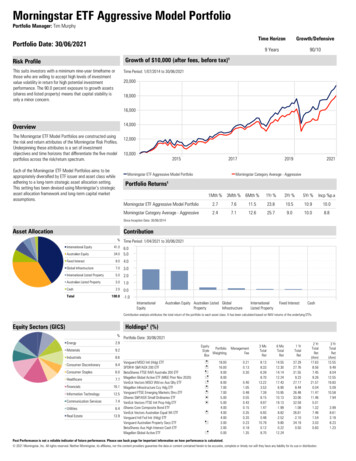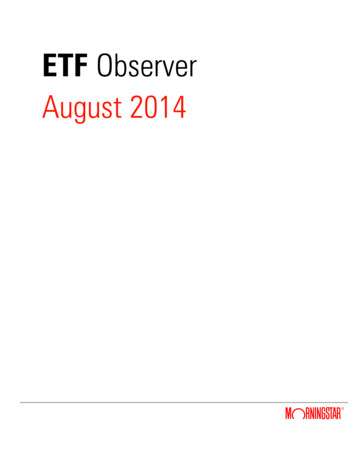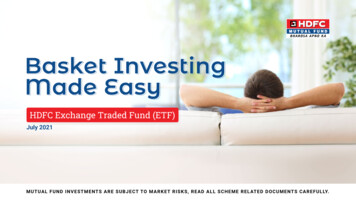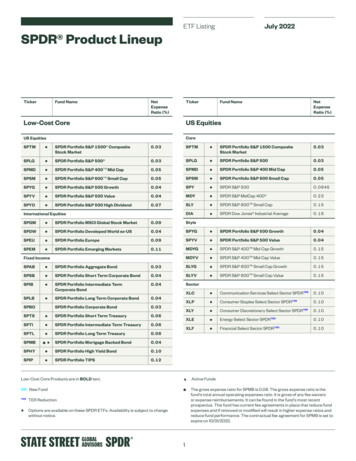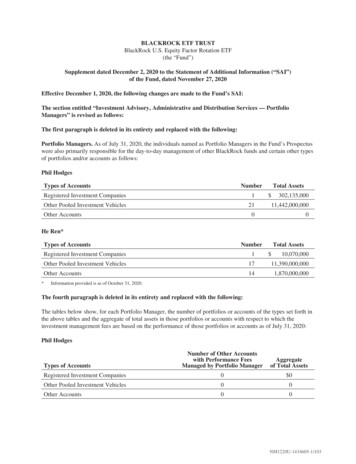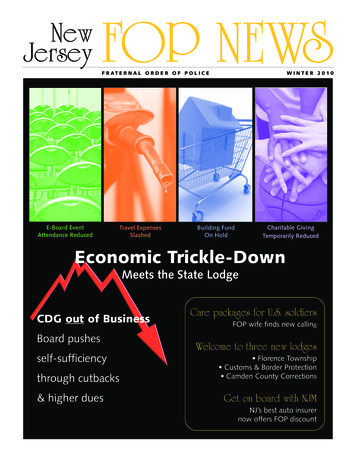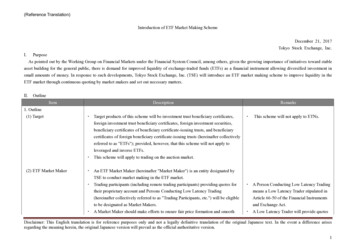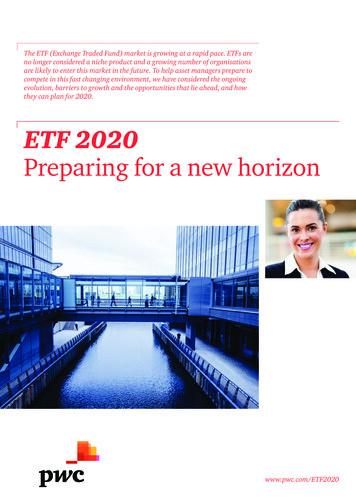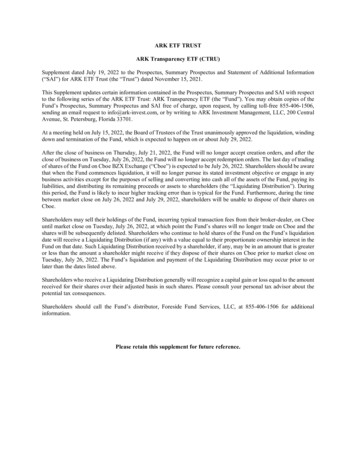
Transcription
ARK ETF TRUSTARK Transparency ETF (CTRU)Supplement dated July 19, 2022 to the Prospectus, Summary Prospectus and Statement of Additional Information(“SAI”) for ARK ETF Trust (the “Trust”) dated November 15, 2021.This Supplement updates certain information contained in the Prospectus, Summary Prospectus and SAI with respectto the following series of the ARK ETF Trust: ARK Transparency ETF (the “Fund”). You may obtain copies of theFund’s Prospectus, Summary Prospectus and SAI free of charge, upon request, by calling toll-free 855-406-1506,sending an email request to info@ark-invest.com, or by writing to ARK Investment Management, LLC, 200 CentralAvenue, St. Petersburg, Florida 33701.At a meeting held on July 15, 2022, the Board of Trustees of the Trust unanimously approved the liquidation, windingdown and termination of the Fund, which is expected to happen on or about July 29, 2022.After the close of business on Thursday, July 21, 2022, the Fund will no longer accept creation orders, and after theclose of business on Tuesday, July 26, 2022, the Fund will no longer accept redemption orders. The last day of tradingof shares of the Fund on Cboe BZX Exchange (“Cboe”) is expected to be July 26, 2022. Shareholders should be awarethat when the Fund commences liquidation, it will no longer pursue its stated investment objective or engage in anybusiness activities except for the purposes of selling and converting into cash all of the assets of the Fund, paying itsliabilities, and distributing its remaining proceeds or assets to shareholders (the “Liquidating Distribution”). Duringthis period, the Fund is likely to incur higher tracking error than is typical for the Fund. Furthermore, during the timebetween market close on July 26, 2022 and July 29, 2022, shareholders will be unable to dispose of their shares onCboe.Shareholders may sell their holdings of the Fund, incurring typical transaction fees from their broker-dealer, on Cboeuntil market close on Tuesday, July 26, 2022, at which point the Fund’s shares will no longer trade on Cboe and theshares will be subsequently delisted. Shareholders who continue to hold shares of the Fund on the Fund’s liquidationdate will receive a Liquidating Distribution (if any) with a value equal to their proportionate ownership interest in theFund on that date. Such Liquidating Distribution received by a shareholder, if any, may be in an amount that is greateror less than the amount a shareholder might receive if they dispose of their shares on Cboe prior to market close onTuesday, July 26, 2022. The Fund’s liquidation and payment of the Liquidating Distribution may occur prior to orlater than the dates listed above.Shareholders who receive a Liquidating Distribution generally will recognize a capital gain or loss equal to the amountreceived for their shares over their adjusted basis in such shares. Please consult your personal tax advisor about thepotential tax consequences.Shareholders should call the Fund’s distributor, Foreside Fund Services, LLC, at 855-406-1506 for additionalinformation.Please retain this supplement for future reference.
ProspectusNovember 30, 2021ARK ETF Trust Thematic Actively-Managed ETFsETFARK Innovation ETFARK Next Generation Internet ETFARK Fintech Innovation ETFETFNYSE Arca, Inc.Ticker SymbolARKKARKWARKFCboe BZXExchange, Inc.Ticker SymbolARK Genomic Revolution ETFARK Autonomous Technology & Robotics ETFARKGARKQARK Space Exploration & Innovation ETFARKXARK ETF Trust Thematic Index ETFsETFThe 3D Printing ETFARK Israel Innovative Technology ETFCboe BZXExchange, Inc.Ticker SymbolPRNTIZRLThe U.S. Securities and Exchange Commission (“SEC”) has not approved or disapproved these securities orpassed upon the accuracy or adequacy of this prospectus. Any representation to the contrary is a criminaloffense.
TABLE OF CONTENTSSUMMARY INFORMATION . . . . . . . . . . . . . .ARK Innovation ETF (ARKK) . . . . . . . . . . . .ARK Next Generation Internet ETF (ARKW)ARK Fintech Innovation ETF (ARKF) . . . . . .ARK Genomic Revolution ETF (ARKG) . . . .11132535ARK Autonomous Technology & Robotics ETF (ARKQ) . . . . . . . . . . . . . . . . . . . . . . . . . .ARK Space Exploration & Innovation ETF (ARKX) . . . . . . . . . . . . . . . . . . . . . . . . . . . . . .The 3D Printing ETF (PRNT) . . . . . . . . . . . . . . . . . . . . . . . . . . . . . . . . . . . . . . . . . . . . . .ARK Israel Innovative Technology ETF (IZRL) . . . . . . . . . . . . . . . . . . . . . . . . . . . . . . . . .Summary Information About Purchases and Sales of Fund Shares, Tax Information andPayments to Broker-Dealers and Other Financial Intermediaries . . . . . . . . . . . . . . . .ADDITIONAL INFORMATION ABOUT THE FUNDS’ INVESTMENT STRATEGIES AND RISKS . .Investment Objective of each Fund . . . . . . . . . . . . . . . . . . . . . . . . . . . . . . . . . . . . . . . .Principal Investment Strategies . . . . . . . . . . . . . . . . . . . . . . . . . . . . . . . . . . . . . . . . . . .Principal Risks . . . . . . . . . . . . . . . . . . . . . . . . . . . . . . . . . . . . . . . . . . . . . . . . . . . . . . . .Additional Investment Strategies . . . . . . . . . . . . . . . . . . . . . . . . . . . . . . . . . . . . . . . . .43526069798080808094Additional Risks . . . . . . . . . . . . . . . . . . . . . . . . . . . . . . . . . . . . . . . . . . . . . . . . . . . . . . .Portfolio Holdings . . . . . . . . . . . . . . . . . . . . . . . . . . . . . . . . . . . . . . . . . . . . . . . . . . . . .9598MANAGEMENT OF THE FUNDS . . . . . . . . . . . . . . . . . . . . . . . . . . . . . . . . . . . . . . . . . . . . .SHAREHOLDER INFORMATION . . . . . . . . . . . . . . . . . . . . . . . . . . . . . . . . . . . . . . . . . . . . .Pricing of Fund Shares . . . . . . . . . . . . . . . . . . . . . . . . . . . . . . . . . . . . . . . . . . . . . . . . . .99101101Buying and Selling Shares . .Distribution and Service PlanDividends and Distributions .Tax Consequences . . . . . . . .101102102103Frequent Purchases and Redemptions of Fund SharesTAX-ADVANTAGED PRODUCT STRUCTURE . . . . . . . . . .INDEX PROVIDER AND INDEX DESCRIPTIONS . . . . . . . .FINANCIAL HIGHLIGHTS . . . . . . . . . . . . . . . . . . . . . . . .PREMIUM/DISCOUNT INFORMATION . . . . . . . . . . . . . .GENERAL INFORMATION . . . . . . . . . . . . . . . . . . . . . . .105106106109118118
SUMMARY INFORMATIONARK Innovation ETF (ARKK)Investment ObjectiveThe ARK Innovation ETF’s (“Fund”) investment objective is long-term growth of capital.Fund Fees and ExpensesThe table below describes the fees and expenses that you pay if you buy, hold and sell shares of theFund (“Shares”). Investors may pay other fees, such as brokerage commissions and other fees tofinancial intermediaries on their purchases and sales of Shares, which are not reflected in the tablesand examples below.Shareholder Fees (fees paid directly from your investment) . . . . . . . . . . . . . . . . . .Annual Fund Operating Expenses(expenses that you pay each year as a percentage of the value of your investment)Management Fee . . . . . . . . . . . . . . . . . . . . . . . . . . . . . . . . . . . . . . . . . . . . . . . . .Distribution and/or Service (12b-1) Fees . . . . . . . . . . . . . . . . . . . . . . . . . . . . . . . .Other Expenses(a) . . . . . . . . . . . . . . . . . . . . . . . . . . . . . . . . . . . . . . . . . . . . . . . . .(a).None.0.75%0.00%0.00%Total Annual Fund Operating Expenses . . . . . . . . . . . . . . . . . . . . . . . . . . . . . . . . . .0.75%Pursuant to a Supervision Agreement, ARK Investment Management LLC (“ARK” or “Adviser”) pays allother expenses of the Fund (other than acquired fund fees and expenses, taxes and governmental fees,brokerage fees, commissions and other transaction expenses, certain foreign custodial fees and expenses,costs of borrowing money, including interest expenses, and extraordinary expenses (such as litigation andindemnification expenses)).ExampleThis example is intended to help you compare the cost of investing in the Fund with the cost ofinvesting in other funds. This example does not take into account brokerage commissions that youpay when purchasing or selling Shares.The example assumes that you invest 10,000 in the Fund for the time periods indicated and thenredeem all of your Shares at the end of those periods. The example also assumes that yourinvestment has a 5% annual return and that the Fund’s operating expenses remain the same.Although your actual costs may be higher or lower, based on these assumptions, your costs wouldbe:YearExpenses13510 77 240 417 930Portfolio TurnoverThe Fund pays transaction costs, such as commissions, when it purchases and sells securities (or“turns over” its portfolio). A higher portfolio turnover rate may result in higher transaction costsand higher taxes when Shares are held in a taxable account. These costs, which are not reflected inannual fund operating expenses or in the example, may affect the Fund’s performance. During themost recent fiscal year, the Fund’s portfolio turnover rate was 71% of the average value of itsportfolio.1
Principal Investment StrategiesThe Fund is an actively-managed exchange-traded fund (“ETF”) that will invest under normalcircumstances primarily (at least 65% of its assets) in domestic and foreign equity securities ofcompanies that are relevant to the Fund’s investment theme of disruptive innovation. The Adviserdefines “disruptive innovation” as the introduction of a technologically enabled new product orservice that potentially changes the way the world works. The Adviser believes that companiesrelevant to this theme are those that rely on or benefit from the development of new products orservices, technological improvements and advancements in scientific research relating to the areasof genomics* (“Genomic Revolution Companies”); innovation in automation and manufacturing(“Automation Transformation Companies”), transportation, energy (“Energy TransformationCompanies”), artificial intelligence (“Artificial Intelligence Companies”) and materials; the increaseduse of shared technology, infrastructure and services (“Next Generation Internet Companies”); andtechnologies that make financial services more efficient (“Fintech Innovation Companies”).In selecting companies that the Adviser believes are relevant to a particular investment theme, theAdviser seeks to identify, using its own internal research and analysis, companies capitalizing ondisruptive innovation or that are enabling the further development of a theme in the markets inwhich they operate. The Adviser’s internal research and analysis leverages insights from diversesources, including external research, to develop and refine its investment themes and identify andtake advantage of trends that have ramifications for individual companies or entire industries. Thetypes of companies that the Adviser believes are Genomic Revolution Companies, AutomationTransformation Companies, Energy Transformation Companies, Artificial Intelligence Companies,Next Generation Internet Companies or Fintech Innovation Companies are described below:* Genomic Revolution Companies. Companies that the Adviser believes are substantiallyfocused on and are expected to substantially benefit from extending and enhancing thequality of human and other life by incorporating technological and scientificdevelopments, improvements and advancements in genomics into their business, such asby offering new products or services that rely on genomic sequencing,** analysis, synthesisor instrumentation. These companies may include ones across multiple sectors, such ashealthcare, information technology, materials, energy and consumer discretionary. Thesecompanies may also develop, produce, manufacture or significantly rely on or enable bionicdevices, bio-inspired computing, bioinformatics,*** molecular medicine and agriculturalbiotechnology. Automation Transformation Companies. Companies that the Adviser believes are focusedon man capitalizing on the productivity of machines, such as through the automation offunctions, processes or activities previously performed by human labor, such astransportation through an emphasis on mobility as a service, or the use of robotics toperform other functions, activities or processes. Energy Transformation Companies. Companies that the Adviser believes seek to capitalizeon innovations or evolutions in: (i) ways that energy is stored or used; (ii) the discovery,collection and/or implementation of new sources of energy, including unconventionalsources of oil or natural gas; and/or (iii) the production or development of new materialsfor use in commercial applications of energy production, use or storage. Artificial Intelligence Companies. Companies that the Adviser considers to be ArtificialIntelligence (“AI”) Companies include a company that: (i) designs, creates, integrates, orThe Adviser defines “genomics” as the study of genes and their functions, and related techniques(e.g., genomic sequencing).** The Adviser uses the term “genomic sequencing” to refer to techniques that allow researchers to read anddecipher the genetic information found in the DNA (i.e., the exact sequence of bases A, C, G and T in aDNA molecule), including the DNA of bacteria, plants, animals and human beings.*** The Adviser defines “bioinformatics” as the science of collecting and analyzing complex biological datasuch as genetic codes.2
delivers robotics, autonomous technology, and/or AI in the form of products, software, orsystems; (ii) develops the building block components for robotics, autonomous technology,or AI, such as advanced machinery, semiconductors and databases used for machinelearning; (iii) provides its own value-added services on top of such building blockcomponents, but are not core to the company’s product or service offering; and/or(iv) develops computer systems that are able to perform tasks that normally require humanintelligence, such as visual perception, speech recognition, decision-making, andtranslation between languages. Next Generation Internet Companies. Companies that the Adviser believes are focusedon and expected to benefit from shifting the bases of technology infrastructure fromhardware and software to the cloud, enabling mobile and local services, such as companiesthat rely on or benefit from the increased use of shared technology, infrastructure andservices. These companies may include mail order houses which generate the entirety oftheir business through websites and which offer internet-based products and services, suchas streaming media or cloud storage in addition to traditional physical goods. Thesecompanies may also include ones that develop, use or rely on innovative paymentmethodologies, big data, the “internet of things*,” machine learning, and socialdistribution and media. Fintech Innovation Companies. Companies that the Adviser believes are focused on andexpected to benefit from the shifting of the financial sector and economic transactions totechnology infrastructure platforms, and technological intermediaries. Fintech InnovationCompanies may also develop, use or rely on innovative payment platforms andmethodologies, point of sale providers, e-commerce, transactional innovations, businessanalytics, fraud reduction, frictionless funding platforms, peer-to-peer lending, blockchaintechnologies,** intermediary exchanges, asset allocation technology, cryptocurrency,***mobile payments, and risk pricing and pooling aggregators. The Fund may have exposureto cryptocurrency, such as bitcoin, indirectly through an investment in a grantor trust. TheFund’s exposure to cryptocurrency may change over time and, accordingly, such exposuremay not always be represented in the Fund’s portfolio.The Adviser will select investments for the Fund that represent its highest-conviction investmentideas within the theme of disruptive innovation, as described above, in constructing the Fund’sportfolio. The Adviser’s process for identifying Genomic Revolution Companies, AutomationTransformation Companies, Energy Transformation Companies, Artificial Intelligence Companies,Next Generation Internet Companies and Fintech Innovation Companies uses both “top down”(thematic research sizing the potential total available market, and surfacing the prime beneficiaries)and “bottom up” (valuation, fundamental and quantitative measures) approaches. In both theAdviser’s “top down” and “bottom up” approaches, the Adviser evaluates environmental, social,and governance (“ESG”) considerations. In its “top down” approach, the Adviser uses theframework of the United Nations Sustainable Development Goals to integrate ESG considerations*The Adviser defines the “internet of things” as a system of interrelated computing devices, mechanicaland digital machines, or physical objects that are provided unique identifiers and the ability to transferdata over a network without requiring human-to-human or human-to-computer interaction.** The term “blockchain” refers to a peer-to-peer distributed ledger that is secured using cryptography. Adistributed ledger is a shared electronic database where information is recorded and stored across multiplecomputers; a blockchain is one type of distributed ledger. A blockchain may be open and permissionless orprivate and permissioned. The Bitcoin and Ethereum blockchains are examples of open, public,permissionless blockchains. Blockchain derives its name from the way it stores transaction data in “blocks”that are linked together to form a chain. As the number of transactions grows, so does the blockchain.Blocks record and confirm the time and sequence of transactions, which are then logged into theblockchain network, which is, with respect to public blockchains, governed by rules agreed on by thenetwork participants.*** Cryptocurrencies (also referred to as “virtual currencies” and “digital currencies”) are digital assetsdesigned to act as a medium of exchange. There are thousands of cryptocurrencies, the most well-knownof which is bitcoin.3
into its research and investment process. The Adviser, however, does not use ESG considerations tolimit, restrict or otherwise exclude companies or sectors from the Fund’s investment universe. In its“bottom up” approach, the Adviser makes its investment decisions primarily based on its analysis ofthe potential of individual companies, while integrating ESG considerations into that process. TheAdviser’s highest-conviction investment ideas are those that it believes present the best risk-rewardopportunities.Under normal circumstances, substantially all of the Fund’s assets will be invested in equity securities,including common stocks, partnership interests, business trust shares and other equity investmentsor ownership interests in business enterprises. The Fund’s investments will include micro-, small-,medium- and large-capitalization companies. The Fund’s investments in foreign equity securitieswill be in both developed and emerging markets. The Fund may invest in foreign securities listed onforeign exchanges as well as American Depositary Receipts (“ADRs”) and Global Depositary Receipts(“GDRs”).The Fund is classified as a “non-diversified” investment company under the Investment CompanyAct of 1940, as amended (the “1940 Act”), which means that it may invest a high percentage of itsassets in a limited number of issuers.Principal RisksThere is no assurance that the Fund will meet its investment objective. The value of yourinvestment in the Fund, as well as the amount of return you receive on your investment in theFund, may fluctuate significantly. You may lose part or all of your investment in the Fund or yourinvestment may not perform as well as other similar investments. Therefore, you should considercarefully the following risks before investing in the Fund. The principal risks of investing in theFund listed below are presented alphabetically to facilitate your ability to find particular risks andcompare them with the risks of other funds. Each risk summarized below is considered a “principalrisk” of investing in the Fund, regardless of the order in which it appears.Authorized Participants Concentration Risk. The Fund has a limited number of financialinstitutions that may act as Authorized Participants (“APs”) on an agency basis (i.e., on behalf ofother market participants). To the extent that those APs exit the business or are unable to processcreation and/or redemption orders, and no other AP is able to step forward to create and redeem ineither of these cases, Shares may possibly trade at a discount to net asset value (“NAV”). The AP riskmay be heightened in the case of ETFs investing internationally because international ETFs oftenrequire APs to post collateral, which only certain APs are able to do.Communications Sector Risk. The Fund will be more affected by the performance of thecommunications sector than a fund with less exposure to such sector. Communication companiesare particularly vulnerable to the potential obsolescence of products and services due totechnological advancement and the innovation of competitors. Companies in the communicationssector may also be affected by other competitive pressures, such as pricing competition, as well asresearch and development costs, substantial capital requirements and government regulation.Additionally, fluctuating domestic and international demand, shifting demographics and oftenunpredictable changes in consumer tastes can drastically affect a communication company’sprofitability. While all companies may be susceptible to network security breaches, certaincompanies in the communications sector may be particular targets of hacking and potential theft ofproprietary or consumer information or disruptions in service, which could have a material adverseeffect on their businesses.Consumer Discretionary Risk. The consumer discretionary sector may be affected by changes indomestic and international economies, exchange and interest rates, competition, consumers’disposable income and consumer preferences, social trends and marketing campaigns.Cryptocurrency Risk. Cryptocurrencies (also referred to as “virtual currencies” and “digitalcurrencies”) are digital assets designed to act as a medium of exchange. Cryptocurrency is anemerging asset class. There are thousands of cryptocurrencies, the most well-known of which is4
bitcoin. The Fund may have exposure to bitcoin indirectly through an investment in the GrayscaleBitcoin Trust (“GBTC”), a privately offered, open-end investment vehicle that invests in bitcoin.Cryptocurrency generally operates without central authority (such as a bank) and is not backed byany government, corporation, or other entity. Cryptocurrency is not generally accepted as legaltender. Regulation of cryptocurrency is still developing. Federal, state and/or foreign governmentsmay restrict the development, use, or exchange of cryptocurrency.The market price of bitcoin has been subject to extreme fluctuations. The price of bitcoin could fallsharply (potentially to zero) for various reasons, including, but not limited to, regulatory changes,issues impacting the bitcoin network, events involving entities that facilitate transactions in bitcoin,or changes in user preferences in favor of alternative cryptocurrencies. Furthermore, events thatimpact one cryptocurrency may lead to a decline in the value of other cryptocurrencies, includingbitcoin.Cryptocurrency exchanges and other trading venues on which cryptocurrencies trade are relativelynew and, in most cases, largely unregulated. Therefore, cryptocurrency exchanges may be moreexposed to fraud and failure than established, regulated exchanges for securities, derivatives andother currencies. Cryptocurrency exchanges may not have the same features as traditionalexchanges to enhance the stability of trading on the exchange, such as measures designed toprevent sudden price swings such as “flash crashes.” As a result, the prices of cryptocurrencies onexchanges may be subject to more volatility than traditional assets traded on regulated exchanges.Cryptocurrency exchanges are also subject to cyber security risks. Cryptocurrency exchanges haveexperienced cyber security breaches in the past and may be breached in the future, which couldresult in the theft and/or loss of bitcoin and other cryptocurrencies and impact the value of bitcoin.Furthermore, cyber security events, legal or regulatory actions, fraud, and technical glitches, maycause a cryptocurrency exchange to shut down temporarily or permanently, which may also affectthe value of bitcoin.The Fund’s investments in GBTC expose the Fund to all of the risks related to cryptocurrenciesdescribed above and also expose the Fund to risks related to GBTC directly. Shares of GBTC maytrade at a significant premium or discount to NAV. To the extent GBTC trades at a discount to NAV,the value of the Fund’s investment in GBTC would typically decrease. Similar to fiat currencies (i.e., acurrency that is backed by a central bank or a national, supra-national or quasi-nationalorganization), cryptocurrencies, including bitcoin, are susceptible to theft, loss and destruction. IfGBTC experiences theft, loss, or destruction of its bitcoin holdings, the Fund’s investments in GBTCcould be harmed. Furthermore, because there is no guarantee that an active trading market forGBTC will exist at any time, the Fund’s investments in GBTC may also be subject to liquidity risk,which can impair the value of the Fund’s investments in GBTC. Investors may experience losses if thevalue of the Fund’s investments in GBTC decline.Cryptocurrency Tax Risk. Many significant aspects of the U.S. federal income tax treatment ofinvestments in bitcoin are uncertain and an investment in bitcoin may produce income that is nottreated as qualifying income for purposes of the income test applicable to regulated investmentcompanies, such as the Fund. GBTC is expected to be treated as a grantor trust for U.S. federalincome tax purposes, and therefore an investment by the Fund in GBTC will generally be treated asa direct investment in bitcoin for such purposes. See “Taxes” in the Fund’s Statement of AdditionalInformation for more information.Currency Risk. Changes in currency exchange rates will affect the value of non-U.S. dollardenominated securities, the value of dividends and interest earned from such securities, gains andlosses realized on the sale of such securities, and derivative transactions tied to such securities. Astrong U.S. dollar relative to other currencies will adversely affect the value of the Fund’sinvestments denominated in those other currencies.Cyber Security Risk. As the use of Internet technology has become more prevalent in the course ofbusiness, funds have become more susceptible to potential operational risks through breaches incyber security. A breach in cyber security refers to both intentional and unintentional events from5
external or internal sources that may cause the Fund to lose proprietary information, suffer datacorruption, lose operational capacity, or result in unauthorized access to confidential information.Such events could prevent the Fund from engaging in normal business activities and cause the Fundto incur regulatory penalties, reputational damage, additional compliance costs associated withcorrective measures and/or financial loss. Cyber security breaches may involve, among other things,unauthorized access to the Fund’s digital information systems through “hacking” or malicioussoftware coding, ransomware attacks that impair the Fund’s ability to access its data or systemsuntil a ransom is paid, or denial-of-service attacks that make network services unavailable tointended users. In addition, cyber security breaches of the Fund’s third-party service providers, suchas its adviser, administrator, transfer agent or custodian, the Fund’s trading counterparties, andissuers in which the Fund invests, can also subject the Fund to many of the same risks associatedwith direct cyber security breaches. Cyber security breaches experienced by an issuer in which theFund invests can also impact the value of the Fund’s investment in that issuer. While the Fund hasestablished business continuity plans and risk management systems designed to reduce the risksassociated with cyber security, there are inherent limitations in such plans and systems. Additionally,there is no guarantee that such efforts will succeed, especially because the Fund does not directlycontrol the cyber security systems of its third-party service providers, trading counterparties, orissuers.Depositary Receipts Risk. Depositary receipts generally involve similar risks to those associatedwith investments in foreign securities. Depositary receipts are securities that are typically issued bya bank or trust company that evidence ownership of underlying securities issued by a foreigncorporation and entitle the holder to all dividends and capital gains that are paid out on theunderlying foreign securities. The issuers of certain depositary receipts are under no obligation todistribute shareholder communications to the holders of such receipts, or to pass through to themany voting rights with respect to the deposited securities. Investments in depositary receipts may beless liquid than the underlying shares in their primary trading market. Depositary receipts may notnecessarily be denominated in the same curren
The last day of trading of shares of the Fund on Cboe BZX Exchange ("Cboe") is expected to be July 26, 2022. Shareholders should be aware that when the Fund commences liquidation, it will no longer pursue its stated investment objective or engage in any
